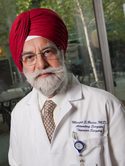| Abstract: |
Purpose: To evaluate the efficacy and toxicity of sequential, dose- intensified chemotherapy with paclitaxel/ifosfamide and carboplatin/etoposide administered plus peripheral blood-derived stem-cell (PBSC) support for patients with germ cell tumors (GCT) who have unfavorable prognostic features in response to conventional-dose salvage programs. Carboplatin was dose escalated by target area under the curve (AUC; in [milligrams per milliliter] x minutes) among patient cohorts, and pharmacokinetic studies were performed for comparison. Patients and Methods: Thirty-seven previously treated patients who had cisplatin-resistant GCT and unfavorable prognostic features for response to conventional-dose salvage therapy were treated. Two cycles of paclitaxel 200 mg/m2 plus ifosfamide 6 g/m2 were given 2 weeks apart with leukapheresis, followed by three cycles of carboplatin plus etoposide given 14 to 21 days apart with reinfusion of PBSCs. The dose of etoposide was 1,200 mg/m2, and the carboplatin target AUC ranged among cohorts from 12 to 32 (mg/mL) x min. Pharmacokinetic studies of carboplatin were performed for comparison of target to measured AUC. Results: Twenty-one patients (57%) achieved a complete response and an additional two patients (5%) achieved a partial response with normal tumor markers; therefore, 23 (62%) achieved a favorable response. Eight patients relapsed, and 15 (41%) of the favorable responses remained durable at a median follow-up of 30 months. Myelosuppression was the major toxicity; 58% of carboplatin/etoposide cycles were associated with hospitalization for nadir fever. The AUC of carboplatin measured in serum was lower than the target AUC; this may be related to underestimation of the glomerular filtration rate used in the dosing formula. Conclusion: Dose-intense therapy with sequential, accelerated chemotherapy of paclitaxel/ifosfamide and carboplatin/etoposide administered with PBSC support was relatively well tolerated. The durable complete response proportion was substantial in patients with unfavorable prognostic features for achieving durable complete response to conventional-dose salvage programs. Optimal dosing of carboplatin in the high-dose setting warrants further investigation. (C) 2000 by American Society of Clinical Oncology. |











